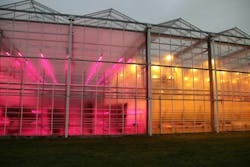Signify is seeing red in its latest LED horticultural lighting experiment: The company is embarking on a new project to determine whether chrysanthemums would benefit from growing under only red light.
While chrysanthemums benefit from blue and far-red (longer wavelength than red) wavelengths under natural light, those two spectra are the most energy intensive in artificial LED lighting.
“It could be very interesting for growers to be able to turn [the lights] off or dim them when the crop doesn't need them,” explained Signify plant specialist Leontiene van Genuchten.
So the Eindhoven, Netherlands lighting company has embarked on a series of experiments in which it is trialing chrysanthemum growth under several different lighting conditions — one of which is growing them under only red light, Signify said in a press release. If the flowers do well, the results would provide an option for growers to use less electricity than what they might otherwise tap.
Signify planted two varieties, one each from Dutch growers Royal van Zanten and Deliflor, in February. It is working with its longtime research collaborator Wageningen University & Research (WUR) at WUR’s Innovation & Demonstration Center in Bleiswijk, the Netherlands, about 50 miles west of WUR’s central location in Wageningen.
The partners are trialing a total of seven different lighting parameters, including red only, as well as mixes of blue, far-red, and other spectra. The team is examining which lighting recipes optimize chrysanthemums for the cut flower market.
It’s known that different crops prefer different mixes of light spectra, intensity, and duration, although scientists are still probing the combinations in order to gain more precise understanding. LED lighting, with its digital programmability, is well suited for delivering and studying varying spectra and their effect on different crops.
“We’re looking forward to the results of this study, in order to gather more information on the optimal combination of natural daylight and LED light,” said Udo van Slooten, business leader of horticulture LED solutions at Signify. “This knowledge will not only be useful for chrysanthemum cultivation, but also applicable to other crops.”
Signify and other vendors have many trials underway examining the effectiveness of different spectra on different crops. Several recent projects look at far red. While far red consumes more electricity than other wavelengths, it can have an elongating effect on stems, which can often be beneficial, such as on certain strawberries in the wintertime, and possibly on mini cucumbers and cannabis.
A commercial trial in Canada by Sollum Technologies and its customer Proplant Propagation is looking at a number of crops including eggplant, cucumber, tomato, and pepper. Sollum is also conducting a study in Bleiswijk — the same Dutch town where Signify and WUR are teaming — with research partner Delphy Improvement Center looking at variable spectra and peppers.
Signify has advised greenhouse growers to minimize the amount of white light, noting that it can be unnecessary for growth and thus can add to the electricity bill for no good reason.
The horticultural lighting business appears to be reviving after a period of stalling, as indicated recently by both Signify and ams Osram.
MARK HALPER is a contributing editor for LEDs Magazine, and an energy, technology, and business journalist ([email protected]).
Follow our LinkedIn page for our latest news updates, contributed articles, and commentary, and our Facebook page for events announcements and more. You can also find us on the X platform.





